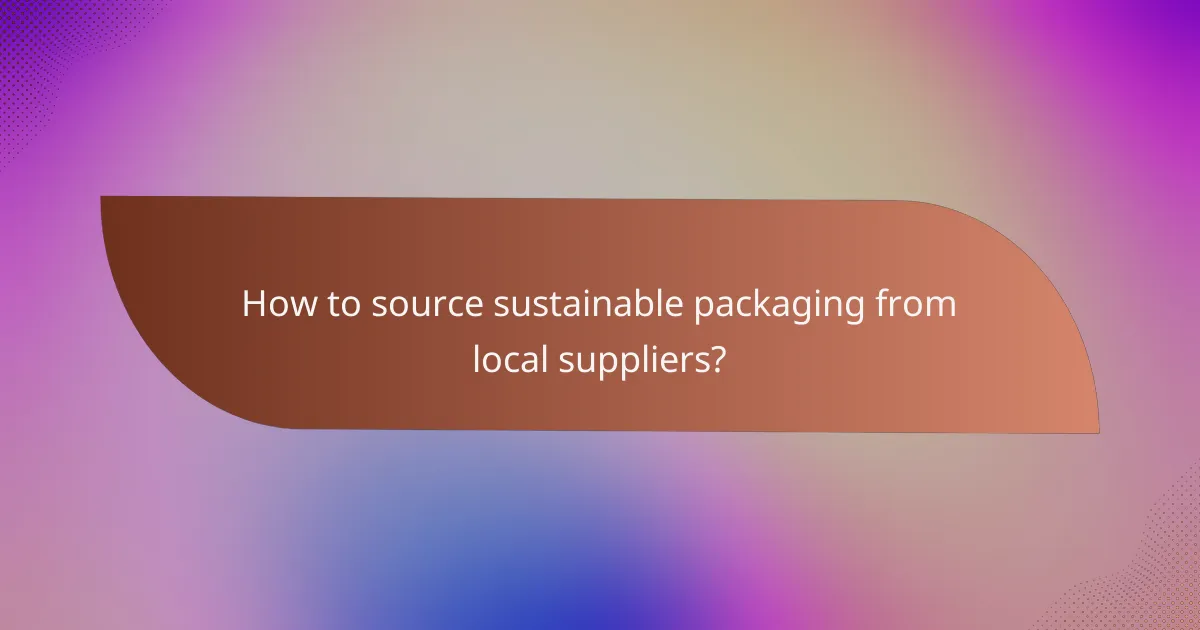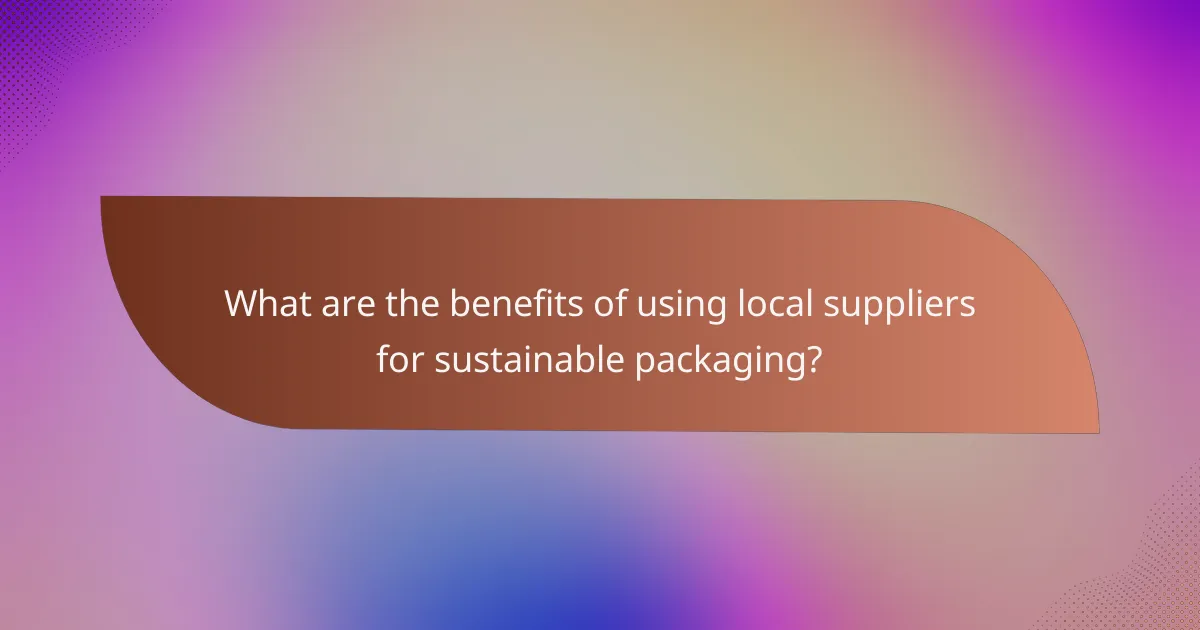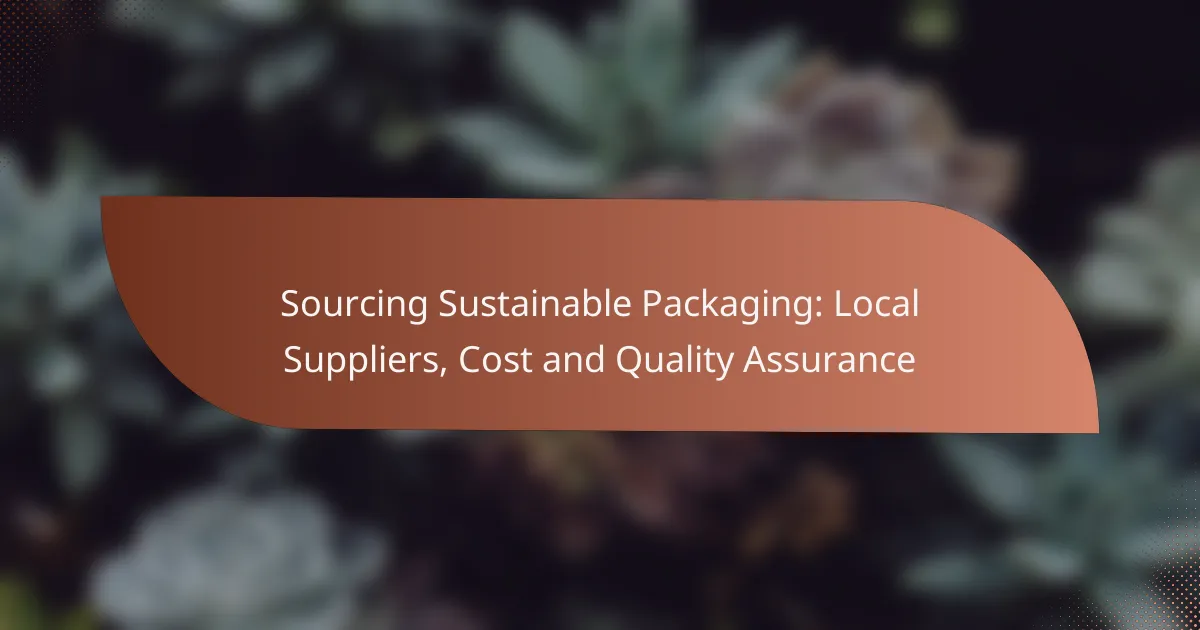Sourcing sustainable packaging from local suppliers is essential for businesses aiming to reduce their environmental impact while supporting their communities. By prioritizing eco-friendly materials and practices, companies can not only lower transportation emissions but also foster local economies. Understanding the cost dynamics and ensuring quality assurance through systematic processes are crucial steps in making informed decisions about sustainable packaging solutions.

How to source sustainable packaging from local suppliers?
Sourcing sustainable packaging from local suppliers involves identifying manufacturers that prioritize eco-friendly materials and practices. This process not only supports local economies but also reduces carbon footprints associated with transportation.
Identify local eco-friendly manufacturers
Start by researching local manufacturers that specialize in sustainable packaging solutions. Look for companies that use recycled materials, biodegradable options, or renewable resources. Local business directories and sustainability-focused platforms can be helpful in finding these suppliers.
Networking with local business associations or attending trade shows can also provide valuable contacts. Engaging with suppliers directly allows for discussions about their sustainability practices and product offerings.
Evaluate supplier certifications
Check for certifications that indicate a commitment to sustainability, such as FSC (Forest Stewardship Council) for paper products or ISO 14001 for environmental management. These certifications ensure that the suppliers adhere to recognized environmental standards.
Additionally, inquire about any third-party audits or assessments that validate their claims. This can provide peace of mind regarding the quality and sustainability of the packaging materials.
Assess production capabilities
Understand the production capabilities of potential suppliers to ensure they can meet your specific packaging needs. Consider factors such as minimum order quantities, lead times, and customization options.
It’s essential to balance quality with scalability; choose suppliers that can grow with your business while maintaining sustainable practices. Request samples to evaluate the quality of their products before making a commitment.
Consider delivery logistics
Evaluate the logistics involved in sourcing from local suppliers, including shipping times and costs. Local suppliers typically offer faster delivery, which can be a significant advantage for businesses needing quick turnaround times.
Additionally, assess the environmental impact of their delivery methods. Suppliers using electric vehicles or optimized routes can further enhance the sustainability of your packaging supply chain.
Research customer reviews
Look for customer reviews and testimonials to gauge the reliability and quality of local suppliers. Online platforms and social media can provide insights into other businesses’ experiences with the suppliers you are considering.
Pay attention to feedback regarding product quality, customer service, and adherence to sustainability claims. A supplier with consistently positive reviews is more likely to meet your expectations for sustainable packaging.

What are the costs associated with sustainable packaging?
The costs associated with sustainable packaging can vary widely based on materials, suppliers, and order quantities. Businesses should consider not only the upfront costs but also the potential long-term savings and environmental benefits.
Compare prices of biodegradable materials
Biodegradable materials can range from slightly higher to significantly more expensive than traditional packaging options. For instance, prices for biodegradable plastics might start at around 1.5 to 3 times the cost of conventional plastics. It’s essential to compare suppliers to find competitive pricing while ensuring quality.
Consider sourcing from local suppliers who may offer better rates due to reduced shipping costs. Additionally, some suppliers provide price lists that can help you gauge the market average for various biodegradable options.
Analyze bulk order discounts
Many suppliers offer substantial discounts for bulk orders, which can significantly lower the per-unit cost of sustainable packaging. Discounts can range from 10% to 30% depending on the quantity ordered. It’s advisable to calculate the break-even point where bulk purchasing becomes more economical.
When negotiating with suppliers, inquire about tiered pricing models that reward larger orders. This approach can help you maximize savings while ensuring a steady supply of packaging materials.
Factor in shipping expenses
Shipping expenses can impact the overall cost of sustainable packaging significantly, especially if sourcing from distant suppliers. Evaluate shipping rates based on the weight and volume of the materials, as well as the delivery timeframes. Local suppliers can often reduce these costs.
Consider consolidating orders to minimize shipping fees. Some suppliers may offer free shipping for orders above a certain threshold, which can further enhance your savings.
Evaluate long-term savings on waste management
Investing in sustainable packaging can lead to long-term savings in waste management costs. By using biodegradable materials, businesses may reduce landfill fees and comply with local regulations that incentivize eco-friendly practices. This can result in savings of several percent on waste disposal over time.
Additionally, companies that adopt sustainable practices often see improved brand loyalty and customer satisfaction, which can translate into increased sales. Weigh these potential savings against the initial costs of sustainable packaging to assess overall value.

How to ensure quality assurance in sustainable packaging?
Ensuring quality assurance in sustainable packaging involves implementing systematic processes to maintain high standards throughout the supply chain. This includes establishing quality control measures, requesting samples, verifying compliance with regulations, and continuously monitoring supplier performance.
Implement quality control processes
Quality control processes are essential for maintaining the integrity of sustainable packaging. Start by defining clear quality criteria based on your product needs, such as material durability, biodegradability, and safety. Regular inspections and audits can help identify any deviations from these standards.
Consider using a checklist that includes key attributes like material certifications, production methods, and environmental impact assessments. This can streamline the evaluation process and ensure consistency in quality across different suppliers.
Request product samples
Requesting product samples is a critical step in assessing the quality of sustainable packaging. Samples allow you to evaluate the materials firsthand, checking for factors such as texture, strength, and overall appearance. This hands-on approach can reveal potential issues that may not be apparent from specifications alone.
When requesting samples, specify the exact requirements and conditions under which the packaging will be used. This ensures that the samples reflect the final product’s performance and suitability for your needs.
Verify compliance with industry standards
Verifying compliance with industry standards is vital for ensuring that your sustainable packaging meets regulatory requirements. Familiarize yourself with relevant standards such as ISO 14001 for environmental management or ASTM D6400 for compostable plastics. These guidelines help ensure that the materials used are safe and environmentally friendly.
Request documentation from suppliers to confirm compliance with these standards. This can include certifications, test results, and declarations of conformity, which provide assurance that the packaging meets established criteria.
Monitor supplier performance
Monitoring supplier performance is crucial for maintaining quality assurance over time. Establish key performance indicators (KPIs) such as delivery times, defect rates, and customer feedback to evaluate supplier reliability. Regular reviews can help identify trends and areas for improvement.
Consider implementing a performance review schedule, such as quarterly assessments, to ensure ongoing compliance with your quality standards. Open communication with suppliers about performance expectations can foster a collaborative approach to quality improvement.

What are the benefits of using local suppliers for sustainable packaging?
Using local suppliers for sustainable packaging offers several advantages, including reduced environmental impact and enhanced community support. By sourcing materials locally, businesses can minimize transportation emissions and foster economic growth in their regions.
Reduced carbon footprint
Local suppliers significantly lower the carbon footprint associated with packaging by reducing transportation distances. This means fewer emissions from trucks and ships, which is crucial in combating climate change. For instance, sourcing packaging materials from a nearby supplier can cut transportation emissions by up to 50% compared to importing from overseas.
Additionally, local suppliers often utilize more sustainable practices, such as using renewable energy sources in their production processes. This further contributes to a smaller overall environmental impact.
Support for local economies
Choosing local suppliers for sustainable packaging directly supports the local economy. When businesses purchase from nearby vendors, they help create jobs and stimulate economic growth within their communities. This can lead to a more resilient local market, which is beneficial for all residents.
Moreover, local suppliers are often more invested in their communities, leading to better relationships and a shared commitment to sustainability goals. This can enhance brand loyalty among consumers who prioritize supporting local businesses.
Faster turnaround times
Local suppliers typically offer faster turnaround times for packaging orders due to shorter shipping distances and more accessible communication. This can be crucial for businesses that need to respond quickly to market demands or changes in production schedules.
For example, a local supplier can often deliver packaging materials within a few days, compared to weeks for international shipments. This agility can help businesses maintain their operational efficiency and reduce inventory costs.
Improved communication and collaboration
Working with local suppliers fosters better communication and collaboration, as businesses can engage directly with their suppliers. This proximity allows for more effective problem-solving and quicker adjustments to packaging designs or materials based on feedback.
Additionally, face-to-face meetings can enhance trust and understanding between parties, leading to stronger partnerships. Local suppliers are often more flexible and willing to accommodate specific needs, which can result in higher quality packaging solutions tailored to a business’s requirements.
